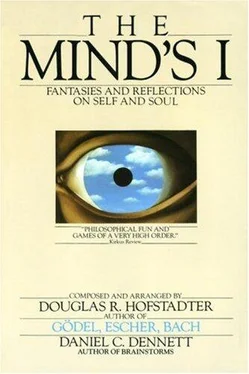The Turing test certainly does make a strong claim about what matters about minds. What matters, Turing proposes, is not what kind of gray matter (if any) the candidate has between his ears, and not what it looks like or smells like, but whether it can act —or behave, if you like—intelligently. The particular game proposed in the Turing test, the Imitation Game, is not sacred, but just a cannily chosen test of more general intelligence. The assumption Turing was prepared to make was that nothing could possibly pass the Turing test by winning the Imitation game without being able to perform infinitely many other clearly intelligent actions. Had he chosen checkmating the world chess champion as his litmus test of intelligence, there would have been powerful reasons for objecting, it now seems quite probable that one could make a machine that can do that but nothing else. Had he chosen stealing the British Crown Jewels without using force or accomplices, or solving the Arab-Israeli conflict without bloodshed, there would be few who would make the objection that intelligence was being “reduced to” behaviour or “operationally defined” in terms of behaviour. (Well, no doubt some philosopher somewhere would set about diligently constructing an elaborate but entirely outlandish scenario in which some utter dolt stumbled into possession of the British Crown Jewels, “passing” the test and thereby “refuting” it as a good general test of intelligence. The true operationalist, of course, would then have to admit that such a lucky moron was by operationalist lights, truly intelligent since he passed the defining test—which is no doubt why true operationalists are hard to find.)
What makes Turing’s chosen test better than stealing the British Crown Jewels or solving the Arab-Israeli conflict is that the latter tests are unrepeatable (if successfully passed once), too difficult (many manifestly intelligent people would fail them utterly) and too hard to judge objectively. Like a well-composed wager, Turing’s test invites trying; it seems fair, demanding but possible, and crisply objective in the judging. The Turing test reminds one of a wager in another way, too. Its motivation is to stop an interminable, sterile debate by saying “Put up or shut up!” Turing says in effect: “Instead of arguing about the ultimate nature and essence of mind or intelligence, why don’t we all agree that anything that could pass this test is surely intelligent, and then turn to ask how something could be designed that might pass the test fair and square?” Ironically, Turing failed to shut off the debate but simply managed to get it redirected.
Is the Turing test vulnerable to criticism because of its “black box” ideology? First, as Hofstadter notes in his dialogue, we treat each other as black boxes, relying on our belief in other minds. Second, the black box ideology is in any event the ideology of all scientific investigation. We learn about the DNA molecule by probing it in various ways and seeing how it behaves in response; we learn about cancer and earthquakes and inflation in the same way. “Looking inside” the black box is often useful when macroscopic objects are our concern, we do it by bouncing “opening” probes (such as a scalpel) off the object and then scattering photons off the exposed surfaces into our eyes. Just one more black box experiment. The question must be, as Hofstadter says: Which probes will be most directly relevant to the question we want to answer? If our question is about whether some entity is intelligent, we will find no more direct, telling probes than the everyday questions we often ask each other. The extent of Turing’s “behaviourism” is simply to incorporate that near truism into a handy, laboratory-style experimental test.
Another problem raised but not settled in Hofstadter’s dialogue concerns representation. A computer simulation of something is typically a detailed, “automated,” multidimensional representation of that thing, but of course there’s a world of difference between representation and reality, isn’t there? As John Searle says, “No one would suppose that we could produce milk and sugar by running a computer simulation of the formal sequences in lactation and photosynthesis”. [8] (See selection 22, “Minds, Brains, and Programs,” p. 375)
If we devised a program that simulated a cow on a digital computer, our simulation, being a mere representation of a cow, would not, if “milked,” produce milk, but at best a representation of milk. You can’t drink that, no matter how good a representation it is, and no matter how thirsty you are.
But now suppose we made a computer simulation of a mathematician, and suppose it worked well. Would we complain that what we had hoped for was proofs, but alas, all we got instead was mere representations of proofs? But representations of proofs are proofs, aren’t they? It depends on how good the proofs represented are. When cartoonists represent scientists pondering blackboards , what they typically represent as proofs of formulae on the blackboard is pure gibberish, however “realistic” these figures appear to the layman. If the simulation of the mathematician produced phony proofs like those in the cartoons, it might still simulate something of theoretical interest about mathematicians—their verbal mannerisms, perhaps, or their absentmindedness. On the other hand, if the simulation were designed to produce representations of the proofs a good mathematician would produce, it would be as valuable a “colleague”—in the proof producing department—as the mathematician. That is the difference it seems, between abstract, formal products like proofs or songs (see the next selection “The Princess Ineffabelle”) and concrete, material products like milk. On which side of this divide does the mind fall? Is mentality like milk or like a song?
If we think of the mind’s product as something like control of the body, it seems its product is quite abstract. If we think of the mind’s product as a sort of special substance or even a variety of substances—lot ’n lots of love, a smidgin or two of pain, some ecstasy, and a few ounces of that desire that all good ballplayers have in abundance—it seems its product is quite concrete.
Before leaping into debate on this issue we might pause to ask if the principle that creates the divide is all that clear-cut at the limits to which we would have to push it, were we to confront a truly detailed, superb simulation of any concrete object or phenomenon. Any actual, running simulation is concretely “realized” in some hardware or other, and the vehicles of representation must themselves produce some effects in the world. If the representation of an event itself produces just about the same effects in the world as the event itself would, to insist that it is merely a representation begins to sound willful. This idea, playfully developed in the next selection, is a recurrent theme throughout the rest of the book.
D.C.D.
6
Stanislaw Lem
The Princess Ineffabelle [9] Excerpt from “The Tale of the Three Story-Telling Machines,” from The Cyberiad by Stanislaw Lem, translated by Michael Kandel. Copyright © 1974 by The Seabury Press, Inc. Reprinted by permission of The Continuum Publishing Corporation.
“There was something....but I forget just what,” said the King, back in front of the Cabinet That Dreamed. “But why are you, Subtillion, hopping about on one leg like that and holding the other?”
“It’s—it’s nothing, Your Highness … a touch of rhombotism … must be a change in the weather,” stammered the craft Thaumaturge, and then continued to tempt the King to sample yet another dream. Zipperupus thought awhile, read through the Table of Contents and chose, “The Wedding Night of Princess Ineffabelle.” And he dreamt he was sitting by the fire and reading an ancient volume, quaint and curious, in which it told, with well-turned words and crimson ink on gilded parchment, of the Princess Ineffabelle, who reigned five centuries ago in the land of Dandelia, and it told of her Icicle Forest, and her Helical Tower, and the Aviary That Neighed and the Treasury with a Hundred Eyes, but especially of her beauty and abounding virtues. And Zipperupus longed for this vision of loveliness with a great longing, and a mighty desire was kindled within him and set his soul afire, that his eyeballs blazed like beacons, and he rushed out and searched every corner of the dream for Ineffabelle, but she was nowhere to be found, indeed, only the very oldest robots had ever heard of that princess. Weary from his long peregrinations, Zipperupus came at last to the centre of the royal desert, where the Dunes were gold plated, and there espied a humble hut; when he approached it, he saw an individual of patriarchal appearance, in a robe as white as snow. The latter rose and spake thusly:
Читать дальше











